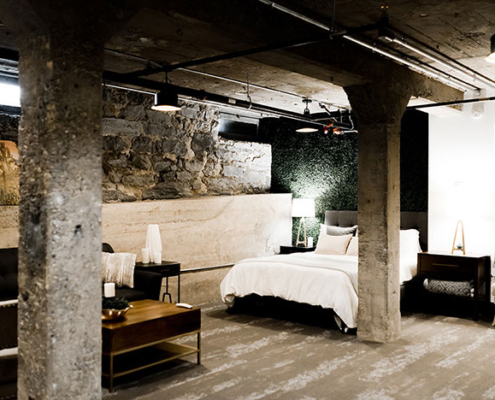 The decision to finish a basement sounds like a simple task, but for homeowners, it can be a daunting and time-consuming process. Not only do you need to consider the layout, design, and functionality of the space, but there is also an added concern of keeping mold out.
The decision to finish a basement sounds like a simple task, but for homeowners, it can be a daunting and time-consuming process. Not only do you need to consider the layout, design, and functionality of the space, but there is also an added concern of keeping mold out.
The ultimate goal of finishing a basement is actually at odds with the critical component of basement waterproofing. This is because the more bare bones your basement is, the easier it is to detect and remediate moisture issues.
Moisture in a basement leads to mold, and mold leads to a variety of negative impacts to health and structural integrity. For this reason, it is critical to use the right materials and procedures when finishing a basement. If you are planning to finish part or all of your basement, here are some tips for keeping your finished basement mold-free.
Jump to article sections:
- Choose The Right Drywall
- Opt for Metal Framing
- Use PVC trim
- Choose Synthetic Carpet
- Pick Antimicrobial Paint
- Improve Basement Ventilation
- Keep Your Home Dry
- Seal Basement Walls and Floors for Waterproofing
- Manage Humidity Levels with a Quality Dehumidifier
- Address Basement Leaks Promptly
Tip 1: Choose The Right Drywall
Standard drywall contains a paper facing that allows for a smoother feeling surface as well as enhancing the wall’s ability to hold paint and primer. However, this same paper facing is also susceptible to retaining moisture in the event of exposure to water.
If you are planning to lay drywall as part of your basement remodel project, make sure to use a drywall that has been specially formulated for moisture protection. A drywall that is formulated for bathroom use is a good choice, as is a paperless version that uses fiberglass mats instead of paper facing to obtain the same form and functionality with added moisture prevention properties.
Tip 2: Opt for Metal Framing
Lumber wall studs are one of the most common ways to frame a home addition. However, when it comes to basements, wooden studs are susceptible to the same kinds of moisture exposure issues as paper facing drywall. For this reason, consider using galvanized steel to frame the finished basement space, coupled with a fiberglass mat style of drywall.
Although steel framing can help with mold prevention, it can still rust if exposed to water. It is therefore critical to separate these steel studs from the concrete with a self-adhering flashing that can be purchased at a low cost from your local home store.
Tip 3: Use PVC trim
Standing water can be a major source of mold growth. Take necessary precautions by using a trim composed of PVC material. This waterproof material can be laid around the trim of cabinets and walls to help reduce moisture exposure. When these PVC trim materials are painted, they look remarkably like painted wood trim.
Tip 4: Choose Synthetic Carpet
If you elect to lay carpet flooring in your basement, opt for a carpet made of synthetic fibers. Synthetic carpets cannot feed mold spores in the same way as natural fibers, rubber flooring, and carpet pads. Many brands of synthetic carpet utilize recycled plastic materials to create the same plush feel underfoot without the risk of mold growth and exposure.
Tip 5: Pick Antimicrobial Paint
An antimicrobial paint can kill mold spores before they grow into a full-blown disaster that requires professional remediation. While many brands sell paint with antimicrobial agents premixed, it is also possible to purchase additives that you can add into your favorite brand or color of paint.
Tip 6: Improve Basement Ventilation
Mold thrives in moist and stagnant environments, making your basement a prime breeding ground. To prevent mold growth, it is essential to improve ventilation in this area of your home.
Consider installing a dehumidifier or adding more vents or windows to increase air circulation. Additionally, regularly check and clean any existing vents or ductwork to ensure optimal airflow.
Tip 7: Keep Your Home Dry
Keeping your home dry is essential for preventing mold in your finished basement. Start by tackling any existing leaks promptly, whether they’re from a faulty roof, plumbing issues, or cracks in your foundation, as even minor water seepage can lead to significant moisture problems over time.
Use a high-quality dehumidifier to maintain an ideal humidity level of 30-50%, especially in damp areas like basements. Lastly, ensure proper drainage around your home by keeping gutters clean and directing downspouts away from the foundation to prevent water accumulation.
Tip 8: Seal Basement Walls and Floors for Waterproofing
Basements are often the most vulnerable to water damage, as they are mostly below ground level and prone to moisture seepage. To protect your basement from potential leaks or floods, it’s essential to seal both the walls and floors.
There are various sealing options available, such as waterproof paint, epoxy coatings, or concrete sealers. Before applying any sealant, make sure to thoroughly clean and dry the surfaces first. This will ensure a proper bond between the sealant and the walls or floors.
When choosing a sealant, make sure to select one that is specifically designed for basements and can withstand high levels of moisture. Follow the instructions carefully and apply multiple coats if needed for maximum effectiveness.
Tip 9: Manage Humidity Levels with a Quality Dehumidifier
Basements are notorious for being damp and humid, which can lead to mold growth and musty odors. In addition to waterproofing and sealing, it’s important to also manage the humidity levels in your basement.
The ideal humidity level for a basement is between 30-50%, so investing in a quality dehumidifier can greatly improve the overall moisture control of your space. When choosing a dehumidifier, look for one with a high capacity and automatic shut-off feature. This will ensure that it can
Tip 10: Address Basement Leaks Promptly
If you notice any leaks or moisture seeping in from outside, it’s important to address them promptly. This could be through repairing cracks in the foundation, installing proper drainage systems, or sealing any gaps or openings where water can enter.
Conclusion
Finishing your basement is no small investment. If you need assistance with keeping your basement dry, reach out to the experts at Zablocki Waterproofing. We have years of experience and the necessary expertise to help you create a dry, comfortable, and usable space in your basement. Don’t let water damage dampen your dreams of a finished basement – contact Zablocki Waterproofing today for trusted Milwaukee basement waterproofing!
 By Dale Granbois, co-owner of Zablocki Waterproofing
By Dale Granbois, co-owner of Zablocki Waterproofing
Dale Granbois is the proud co-owner of Zablocki Waterproofing, the premier basement waterproofing and foundation repair service provider in Milwaukee. Our team of experienced professionals offer a variety of services from complete basement waterproofing solutions to structural foundation repairs -all designed to keep your home or business safe and dry. Let us save you from expensive headaches caused by water damage and give you peace of mind with a safe and secure property. Contact us today for more information!





